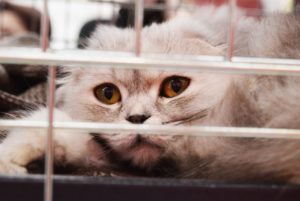
During COVID-19, more and more people are considering a pet. The general argument: time and companionship. However, the heightened interest has led to worries for shelters and breeders about the impact of COVID-19. What happens to these animals after the pandemic?

Just as dogs are not for Christmas, cats are not for COVID-19. Pets are a lifelong commitment and not a mental health solution as the famous slogan coined 40 years ago by the UK Dog’s Trust still reminds us today.
The trust even provides a questionnaire “Are you dog ready?” for potential new owners during the lockdown to give you an idea of the needs and responsibilities of caring for a pet.
Studies have shown that the bond between people and their pets can increase fitness, lower stress, and bring happiness to their owners according to the US Centre for Disease Control and Prevention (CDC), however, mental health and other benefits can also be achieved without owning one.
There are other alternatives that can be as easy as opening your browser. From hands on to hands-off, these three options can help you improve your mental health in quarantine.
1. Foster an animal
Adopting is not the only option. The RSPCA Australia has provided a guide for fostering in each state to understand the requirements, responsibilities, and options from short-term to long-term fostering, kittens, puppies, nursing mums, and grown pets.
Australia is still in Kitten Season from September all the way through to May as shelters see tiny kittens coming in, desperate for help according to the Australian Animal Protection Society (AAPS).
Hannah Shaw, alias The Kitten Lady, is a US-based animal rights advocate, foster carer, YouTube personality, and author. She has started a whole channel on how she fosters kittens providing resources in short comprehensive videos “to help support first-time fosters and adopters” such as the Webinar series Catology and explains why fostering might be the perfect option for people in quarantine.
While fostering requires effort and learning some new skills to provide your furry guest with the comfort it needs, interactions such as petting pets also have stress-relieving physiological benefits for yourself.
“Just 10 minutes can have a significant impact,” says Patricia Pendry, an associate professor in WSU’s Department of Human Development according to her study published in AERA Open.
However, fostering an animal is a responsibility and meant to improve the animals’ lives and conditions until they find their forever home. During COVID-19 restrictions, anyone fostering also needs to be aware of the special requirements that the Sydney animal rescue DCH has summed up to help you decide if this is the right option for you.
Watching animals online at home
If having an animal at home is not an option for you, don’t worry. Just watching cute kittens or other animals on YouTube or Instagram can give your mental health a boost without moving away from the couch according to a study by Associate Professor Jessica Myrick at Penn State University.
“Given that we are spending more time at home and facing a lot of stress during the COVID-19 pandemic, watching an animal video is a quick and easy way to potentially boost your mood”, says Myrick.
“I think my research on cat videos tells us that there is media content out there that can make us feel good and feel energized.”
While most of the research is looking at the phenomenon of funny cat videos, the same goes for any other cute and happy animal video or live stream as Myrick’s study found humour to play an important role in enhancing achievements and attitudes.
“If you are more of a dog person, try watching a few dog videos”, says Myrick. “Everything should be done in moderation, though. A full day of watching any kind of media might not provide a boost, especially as you become desensitized or habituated to the content.”
As funny animals do not have to be pets, you can get your daily dose of cuteness from Taronga Zoo in Sydney. Taronga Zoo TV is live streaming with various 24-hour channels of Capybaras, Otters, Elephants, Tigers, Meerkats, and Koalas.
Playing with AR animals at home
If you would prefer a more playful and interactive option, consider wandering around your home with an Augmented Reality (AR) animal. These 3D animals are easily accessible on your phone with apps such as Google AR Real Animals and Endangered Animals or through Google Chrome.
“There is a growing body of literature that says that media is one important way that people cope with stress and anxiety”, says Associate Professor Myrick. “Compared to traditional 2D video, virtual reality and augmented reality provide users with a more realistic, immersive media experience.”
While there is no specific research on AR technology and specifically animals yet, Myrick says that “viewing animals through virtual reality or augmented reality could make audiences feel like an animal is right there next to them, providing a sense of presence not easily conjured by photos or regular video.”
More proof for the benefits of cute animals comes from Japan where a study on ‘Kawaii’, which translates to cute in Japanese, says that “cute things are popular because they produce positive feelings” and can also make you more productive.
“So, if you are aware that you are feeling down or tired, it might be a good idea to pull up a couple of cat videos and see if you feel better afterward”, suggests Jessica Myrick. “If you notice patterns in your feelings and both the amount and type of media use then you can start to use media in more informed ways to help you manage your emotions.”
Going back to normal?
With quarantine measures slowly easing in Australia, the talk about going back to normal has become a constant. However, how will this normal look like? And what would it look like with a pet?
While companionship and mental wellbeing are all reasons to consider a pet, you need to have the time, energy and financial stability to provide for your pet long term.
Possibly, having a couple of kittens around to cuddle during quarantine is a happy medium between responsibility and the reality of the daily hustle when quarantine ends. Maybe watching cute puppies play online or in your AR app is already enough of a daily dose of animal support.
However, if you are still considering your own pet after endless animal live streams or even fostering, consider adopting one that is already looking for a new forever home in one of the shelters around the country or contact your local RSPCA department.
Resources
While animals can be a great source of emotional support if you are experiencing mental health issues please reach out to your health care provider or one of these online resources:
Lifeline: Phone 13 11 14
Mental Health Australia for further resources




Be the first to comment